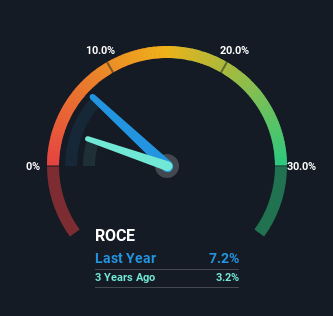We Like These Underlying Return On Capital Trends At Dalrymple Bay Infrastructure (ASX:DBI)
To find a multi-bagger stock, what are the underlying trends we should look for in a business? Ideally, a business will show two trends; firstly a growing return on capital employed (ROCE) and secondly, an increasing amount of capital employed. Put simply, these types of businesses are compounding machines, meaning they are continually reinvesting their earnings at ever-higher rates of return. With that in mind, we've noticed some promising trends at Dalrymple Bay Infrastructure (ASX:DBI) so let's look a bit deeper.
Understanding Return On Capital Employed (ROCE)
Just to clarify if you're unsure, ROCE is a metric for evaluating how much pre-tax income (in percentage terms) a company earns on the capital invested in its business. Analysts use this formula to calculate it for Dalrymple Bay Infrastructure:
Return on Capital Employed = Earnings Before Interest and Tax (EBIT) ÷ (Total Assets - Current Liabilities)
0.072 = AU$234m ÷ (AU$3.9b - AU$590m) (Based on the trailing twelve months to December 2023).
So, Dalrymple Bay Infrastructure has an ROCE of 7.2%. In absolute terms, that's a low return, but it's much better than the Infrastructure industry average of 3.8%.
View our latest analysis for Dalrymple Bay Infrastructure
In the above chart we have measured Dalrymple Bay Infrastructure's prior ROCE against its prior performance, but the future is arguably more important. If you'd like to see what analysts are forecasting going forward, you should check out our free analyst report for Dalrymple Bay Infrastructure .
The Trend Of ROCE
Dalrymple Bay Infrastructure has not disappointed with their ROCE growth. Looking at the data, we can see that even though capital employed in the business has remained relatively flat, the ROCE generated has risen by 126% over the last three years. So it's likely that the business is now reaping the full benefits of its past investments, since the capital employed hasn't changed considerably. On that front, things are looking good so it's worth exploring what management has said about growth plans going forward.
The Key Takeaway
To sum it up, Dalrymple Bay Infrastructure is collecting higher returns from the same amount of capital, and that's impressive. And investors seem to expect more of this going forward, since the stock has rewarded shareholders with a 50% return over the last three years. With that being said, we still think the promising fundamentals mean the company deserves some further due diligence.
Dalrymple Bay Infrastructure does come with some risks though, we found 2 warning signs in our investment analysis, and 1 of those is concerning...
While Dalrymple Bay Infrastructure isn't earning the highest return, check out this free list of companies that are earning high returns on equity with solid balance sheets.
Have feedback on this article? Concerned about the content? Get in touch with us directly. Alternatively, email editorial-team (at) simplywallst.com.
This article by Simply Wall St is general in nature. We provide commentary based on historical data and analyst forecasts only using an unbiased methodology and our articles are not intended to be financial advice. It does not constitute a recommendation to buy or sell any stock, and does not take account of your objectives, or your financial situation. We aim to bring you long-term focused analysis driven by fundamental data. Note that our analysis may not factor in the latest price-sensitive company announcements or qualitative material. Simply Wall St has no position in any stocks mentioned.

 Yahoo Finance
Yahoo Finance 
